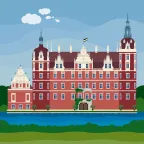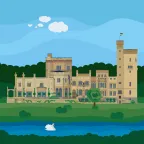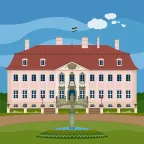Prince Pückler’s Gardens
Prince Hermann von Pückler-Muskau was a German nobleman, author, bon vivant, world traveller and garden designer. His interest in gardens and landscape design was aroused as a young man. Pückler, who is considered to be the most important Prussian garden artist, designed three large landscape parks, in the course of his life.
- First the park around Muskau Palace, where he grew up,
- later the Babelsberg Park in Potsdam, commissioned by the emperor, and
- lastly Branitz Park around Branitz Palace, where he spent the rest of his life.
These three parks are still preserved for posterity, are considered garden monuments, and serve as green oases for the recreation of visitors.
The highest degree of landscape gardening is only reached where it appears to be free nature again, but in its noblest form.
-

Bad Muskau
Bad Muskau is a town in Saxony on the banks of the Neisse river. It gained worldwide fame through its landscape park. Built by Prince Hermann von Pückler-Muskau, it is the largest English-style landscape park in Europe. The UNESCO World Heritage Site is divided between Germany and Poland.
It was in 1785 that Hermann von Pückler-Muskau was born into the house of Saxony, that is to say, more precisely, in the Muskau Castle, which was an estate established by his mother's family, the Counts von Callenberg, and which came to him in inheritance in 1811.
In 1815, Prince Pückler started forming the lands around the New Moscow Castle into a landscape park. He went so far as to completely move a village and put in two new bridges there – the English Bridge and the Double Bridge – over the Neisse River. His ideas were closely intertwined with the characteristics of English landscaping, which he commented upon at length during His travels around the country. These encompass curving, natural-seeming paths, a lack of rigid structures and straight lines, and visual axes that enable the park's visitors to constantly discover something new. A landscape painting technique that operates via levels and breaks the landscape down into foreground, background and intervening space also plays its part.
As work on his first green oasis got underway, the prince became steadily more heavily in debt. Saving, budgeting, or dealing with money generally were not his strengths. Still, a park without precedent was created. To this day, Muskauer Park is divided into a German part to the west of the Lusatian Neisse, which marks the border between them, and a Polish part to the south. Europe's largest English-style landscape park has formed the transnational UNESCO World Heritage Site Muskauer Park Mużakowski since 2004 and is found solely in no other world region.
-

Potsdam
-
Country
Germany
- Region Brandenburg
- Jahr 2022
Potsdam is the capital of Brandenburg and the former residence of the kings of Prussia. The city is rich in parks and castles and the cultural landscape is a UNESCO World Heritage Site. The Babelsberg film park is one of Europe most modern film studios, in 1926 “Metropolis” by Fritz Lang was produced here.
From 1833 to 1849, a summer residence, Babelsberg Palace, was built in several phases for Emperor Wilhelm I when he was a prince. Prince Pückler knew Empress Augusta von Sachsen-Weimar-Eisenach quite well from Weimar, and his book "Andeutungen über Landschaftsgärtnerei - Hints on Landscaping" was just published there. If it were a matter of continuing the work Peter Joseph Lenné had accomplished in the park of the new Babelsburg Castle, built for the emperor Wilhelm I, then the prince played the sound connections card and received the position of garden planner under excellent terms—in a word, free hands in all decisions.
The terraced palace, with its big Pleasure ground, "pancake beds," terracing, planting of the Rose Staircase with white and red roses, the artificial water features, fountains, and lakes, and, above all, the visual axes to the neighbouring lakes, were all designed and executed by Pückler himself. The prince put many of his ideas into practice in creating a harmonious, not laid-out, but naturally-grown park, such as his time, in an English garden. Since 1990, the park has belonged culturally to the landscape of Potsdam and Berlin, crowned with Palaces and Parks, and is part of UNESCO-World Heritage. For this, in 2016, the announcement was that Park Babelsberg is shining in old splendour again and status like a relaxed parkland for ideas.
-
Country
-

Cottbus
-
Country
Germany
- Region Brandenburg
- Jahr 2021
Cottbus is the second-largest city in Brandenburg and is considered the cultural centre of the Sorbs in Lower Lusatia. It is known for the State Theater, the Branitzer Park around Branitz Castle built by Hermann von Pückler-Muskau and the Olympic Training Centre, which is very successful in the field of cycling.
Deeply indebted, Pückler had to sell his own Muskau in 1845. However, he didn't have to live on the street too. He had just withdrawn into his second real estate, the manors, Branitz, in which, as early as 1696, he owned the family of the Pückler. With the vast sums of money that he has gained with the sale of Muskau, he could eliminate his striking, almost unsurmountable pile of debt. What he had left, he said, invested the same year, he was 60, in the landscaping of his new domicile nearby Cottbus. Branitz, the prince, called his masterpiece and said he had from nothing bothered to make Branitz for before what Branitz that was a desert. He was expensive on a few lakes and canals, and with the dug earth, he built his hills and planted them with trees and shrubs. He divided the park into two zones: the "internal park," with the nursery and the castle, and the "external park," which encircled the internal region.
The prince died at Branitz Palace on 4 February 1871. During a walk in the park, one discovers two earth pyramids, the largest of which is called the Tumulus; it is placed inside the Pyramid Lake. Also buried in the pyramid are Prince Hermann von Pückler-Muskau and, reputedly his temporary wife, Lucie. The park is a monument of enormous importance to gardening the world over, and the Fürst-Pückler-Museum Park und Schloss Branitz Foundation is working to get this lifework listed by UNESCO as a World Heritage Site. The vast exhibition housed by the High Baroque residence, spontaneously rebuilt during his lifetime by the prince, also contains the authentically restored rooms that now render insight into the life of the worldly prince.
-
Country
Whoever wants to get to know me completely
must know my garden,
for my garden
is my heart.
All three large landscape parks that the Prince designed during his lifetime can be experienced again today in their original splendour and can be visited free of charge.
- The exhibition in Schloss Muskau is very interactive and attractively designed. It includes a short play, the opportunity to write a love letter as well as Pückler’s family tree as a fun short film. Our highlight was the unique journey through Pückler’s book “Andeutungen über Landschaftsgärtnerei (Hints on Landscape Gardening)”.
- The exhibition in Branitz Palace impresses with its faithfully recreated rooms and gives a deeper insight into the life of the prince and the times of that time. The visitor centre offers, among other things, the opportunity to dive into the Thames in London, to take a balloon ride over the park and to design your own park with building blocks.
- Unfortunately, Babelsberg Palace can currently only be visited during special events.
A map showing the three gardens created by Fürst Pückler.


